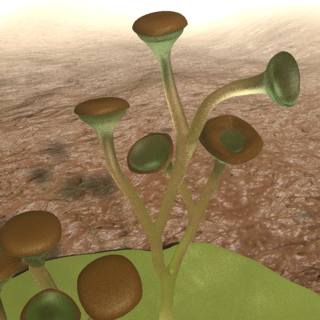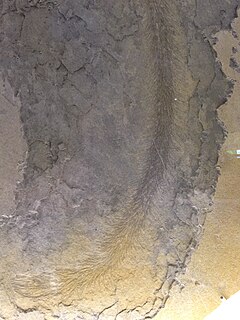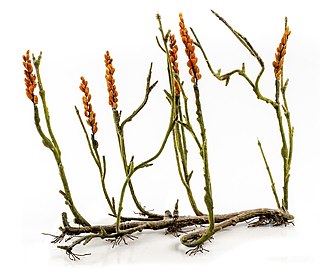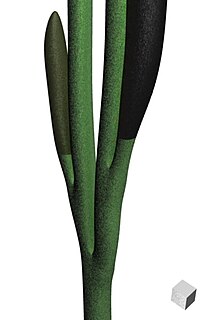
The Silurian is a geologic period and system spanning 24.6 million years from the end of the Ordovician Period, at 443.8 million years ago (Mya), to the beginning of the Devonian Period, 419.2 Mya. The Silurian is the shortest period of the Paleozoic Era. As with other geologic periods, the rock beds that define the period's start and end are well identified, but the exact dates are uncertain by a few million years. The base of the Silurian is set at a series of major Ordovician–Silurian extinction events when up to 60% of marine genera were wiped out.

The lycophytes, when broadly circumscribed, are a vascular plant (tracheophyte) subgroup of the kingdom Plantae. They are sometimes placed in a division Lycopodiophyta or Lycophyta or in a subdivision Lycopodiophytina. They are one of the oldest lineages of extant (living) vascular plants; the group contains extinct plants that have been dated from the Silurian. Lycophytes were some of the dominating plant species of the Carboniferous period, and included tree-like species, although extant lycophytes are relatively small plants.

Cooksonia is an extinct group of primitive land plants, treated as a genus, although probably not monophyletic. The earliest Cooksonia date from the middle of the Silurian ; the group continued to be an important component of the flora until the end of the Early Devonian, a total time span of 433 to 393 million years ago. While Cooksonia fossils are distributed globally, most type specimens come from Britain, where they were first discovered in 1937. Cooksonia includes the oldest known plant to have a stem with vascular tissue and is thus a transitional form between the primitive non-vascular bryophytes and the vascular plants.

The zosterophylls are a group of extinct land plants that first appeared in the Silurian period. The taxon was first established by Banks in 1968 as the subdivision Zosterophyllophytina; they have since also been treated as the division Zosterophyllophyta or Zosterophyta and the class or plesion Zosterophyllopsida or Zosteropsida. They were among the first vascular plants in the fossil record, and had a world-wide distribution. They were probably stem-group lycophytes, forming a sister group to the ancestors of the living lycophytes. By the late Silurian a diverse assemblage of species existed, examples of which have been found fossilised in what is now Bathurst Island in Arctic Canada.

Baragwanathia is a genus of extinct lycopsid plants of Late Silurian to Early Devonian age, fossils of which have been found in Australia, Canada, China and Czechia. The name derives from William Baragwanath who discovered the first specimens of the type species, Baragwanathia longifolia, at Thomson River.

Psilophyton is a genus of extinct vascular plants. Described in 1859, it was one of the first fossil plants to be found which was of Devonian age. Specimens have been found in northern Maine, USA; Gaspé Bay, Quebec and New Brunswick, Canada; the Czech Republic; and Yunnan, China. Plants lacked leaves or true roots; spore-forming organs or sporangia were borne on the ends of branched clusters. It is significantly more complex than some other plants of comparable age and is thought to be part of the group from within which the modern ferns and seed plants evolved.

Cosmochlaina is a form genus of nematophyte – an early plant known only from fossil cuticles, often found in association with tubular structures. The form genus was put forwards by Dianne Edwards, and is diagnosed by inwards-pointing flanges and randomly oriented pseudo-cellular units. Projections on the outer surface are always present, and sometimes also appear on the inner surface; however, the surface of the cuticle itself is always smooth. The holes in the cuticle are often covered by round flaps, loosely attached along a side.

Leclercqia is a genus of early ligulate lycopsids (clubmosses), known as fossils from the Middle Devonian of Australia, North America, Germany, and Belgium. It has been placed in the Protolepidodendrales.

Zosterophyllum was a genus of Silurian-Devonian vascular land plants with naked branching axes on which usually kidney-shaped sporangia were arranged in lateral positions. It is the type genus for the group known as zosterophylls, thought to be part of the lineage from which modern lycophytes evolved. More than 20 species have been described.

Polysporangiophytes, also called polysporangiates or formally Polysporangiophyta, are plants in which the spore-bearing generation (sporophyte) has branching stems (axes) that bear sporangia. The name literally means 'many sporangia plant'. The clade includes all land plants (embryophytes) except for the bryophytes whose sporophytes are normally unbranched, even if a few exceptional cases occur. While the definition is independent of the presence of vascular tissue, all living polysporangiophytes also have vascular tissue, i.e., are vascular plants or tracheophytes. Extinct polysporangiophytes are known that have no vascular tissue and so are not tracheophytes.
Sawdonia is an extinct genus of early vascular plants, known from the Upper Silurian to the Lower Carboniferous. Sawdonia is best recognized by the large number of spikes (enations) covering the plant. These are vascular plants that do not have vascular systems in their enations. The first species of this genus was described in 1859 by Sir J. William Dawson and, was originally attributed to the genus Psilophyton. He named this plant Psilophyton princeps. In 1971 Francis Hueber proposed a new genus for this species due to its "Divergent technical characters from the generic description for Psilophyton." The holotype used for description is Dawson Collection Number 48, pro parte, Museum Specimen Number 3243. Sir J. William Dawson Collection, Peter Redpath Museum, McGill University, Montreal, Quebec, Canada.
This article attempts to place key plant innovations in a geological context. It concerns itself only with novel adaptations and events that had a major ecological significance, not those that are of solely anthropological interest. The timeline displays a graphical representation of the adaptations; the text attempts to explain the nature and robustness of the evidence.

Salopella is a form genus for small fossil plants of Late Silurian to Early Devonian age. The diagnostic characters are naked axes branching isotomously, terminating in fusiform sporangia. The sporangia are unbranched, but in at least the type species the axes seem to branch just under the sporangia. It differs from the similar form genus Tortilicaulis in that the sporangia do not have spirally arranged cells, and from other similar form genera such as Cooksonia, Uskiella and Tarrantia in the shape of the sporangia.

Adoketophyton is a genus of extinct vascular plants of the Early Devonian. The plant was first described in 1977 based on fossil specimens from the Posongchong Formation, Wenshan district, Yunnan, China. These were originally named Zosterophyllum subverticillatum; later the species was transferred to a new genus as Adoketophyton subverticillatum. One cladistic analysis suggested that it is a lycophyte, related to the zosterophylls. Other researchers regard its placement within the vascular plants as uncertain.
Distichophytum is a genus of extinct vascular plants of the Late Silurian (Ludfordian) to Early Devonian (Emsian), around 426 to 393 million years ago. The genus has a tangled taxonomic history, also being known as Bucheria and Rebuchia.
Celatheca is a genus of extinct plants of the Early Devonian. Fossils were first found in the Posongchong Formation of eastern Yunnan, China. The leafless stems (axes) divided dichotomously but unequally so that one branch formed more of a 'main' stem and the other a side branch system. Side branches which did not bear spore-forming organs or sporangia divided two or three times further, ending in tips which curled back on themselves. Side branches bearing sporangia ultimately divided to produce a group of four sporangia, each with an outer leaf-like bract which folded around the sporangium. Celatheca resembles the Australian fossil Yarravia.
Jugumella is a genus of extinct plants of the Late Silurian. Fossils were found in Kazakhstan. Jugumella was considered a possible zosterophyll in a 2006 study. It was listed as a zosterophyll by Hao and Xue in 2013.
Lycopodolica is a genus of extinct plants of the Late Silurian. Fossils were found in the Rashkov Beds in Podolia in modern Ukraine. Plants there are preserved as compressions without internal detail. Lycopodolica had stems (axes) which appear to have branched and which are covered with lax, hair- or thread-like outgrowths. Considered to be a lycophyte, Lycopodolica differs from Baragwanathia in the nature of its outgrowths or enations. It was listed as a lycopsid by Hao and Xue in 2013.
Yarravia is a genus of extinct vascular plants mainly known from fossils found in Victoria, Australia. Originally the rocks in which they were found were considered to be late Silurian in age; more recently they have been found to be Early Devonian. Specimens consist only of incomplete leafless stems, some of which bore groups of spore-forming organs or sporangia which were fused, at least at the base.
The Yea Flora Fossil Site is a roadside cutting on Limestone Road, Yea, Victoria, Australia. It contains fossils of genus Baragwanathia, some of the world's earliest vascular plants dating back to the begin of the Devonian period, 415 million years ago.











